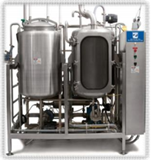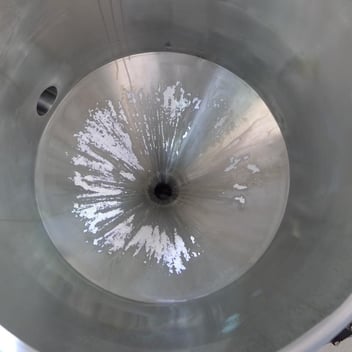In The Field - Detergent Coverage
Making sure that cleaning agents can reach all areas of the soiled equipment often poses a challenge that manufacturers may not be prepared for. While Dober prides itself on providing detergent solutions that are specifically matched to combat specific residues, even the best cleaning agent in the world would be ineffective if it cannot reach the area that needs to be cleaned.
An excellent example of this, that I have observed in the field, applies to the cleaning of pan coaters. At Dober, we like to eliminate as much manual cleaning as possible, but certain models of coating pans, especially those that are older, were not designed with cleaning in mind, making it difficult to provide a truly “hands-off” cleaning recommendation.
Ideally, where a fully automated CIP/WIP system is unavailable, cleaning a coating pan would consist of filling the sump with enough detergent solution to cover the lower portion of the perforated drum and the pan baffles. The drum would be rotated through the liquid in the sump at a slow speed, creating a cascading cleaning action. While this is being done, detergent solution would also be sprayed through the lines and spray guns which would be angled to spray onto the front and back walls of the pan coater. Realistically, this is not always possible due to some or all of the following reasons
- Some sumps are shallow and cannot be filled to a level that fully submerges the drum and baffles.
- Some pans do not have proper seals and gaskets to be able to fill without leaking.
- Many spray arm assemblies do not allow for guns to be rotated individually. When this happens, there can be many spots within a coating pan that do not see consistent contact with a cleaning solution.
I once attended a trial with these exact issues. We were there to implement cleaning of a coating pan that had been soiled with a red-pigmented enteric coating. Many layers of coating solution had been applied and cured in order to simulate a full production campaign. With the sump filled to capacity, only a small portion of the perforated drum was fully submerged. The edges of the pan baffles were never covered by the detergent solution. At the same time, the positions of all of the spray guns were fixed and could not be changed. Due to these factors, we observed that the perforated pan was completely clean in the center, while there was residue remaining on the edges of the baffles and the center of the back wall on the coating drum. All areas where the detergent was consistently in contact with the surface for the duration of the trial, were clean. It was only the areas where the detergent could not reach, that still had residue.
In situations like this, the options to get a 100% clean result are to either go in and perform a manual clean with cloths, scrub brushes or spray wands or make the necessary engineering changes to the equipment allowing for direct detergent contact in those problem areas. In this case, the customer chose to use spray hand-held spray bottles to reapply detergent solution to the areas that lacked detergent coverage during the cleaning cycle and wiped all remaining residue away with cloths. Implementing an efficient cleaning process with Chematic helps to achieve your individual cleaning goals. Whether they are to eliminate manual cleaning with an additional investment that would save time and effort in long term or to have flexibility with manual cleaning and saving initial costs but compromising on manual cleaning time for all future cleaning cycles.



